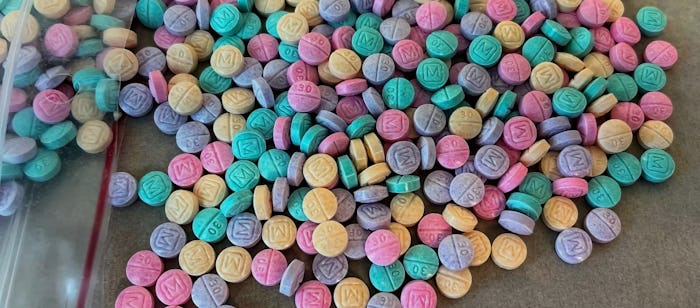News
What Parents Need To Know After DEA Issues Warning About "Rainbow Fentanyl"
Fear is understandable, but many experts agree there’s no need to panic.
A new influx of brightly-colored fentanyl tablets, powders, and blocks that look like sidewalk chalk have the Drug Enforcement Administration (DEA) warning parents to be on the lookout for pills they believe are an attempt by the cartels to target younger demographics. But while the dangers of synthetic opioids like fentanyl, rainbow or otherwise, cannot be overstated, harm reduction experts and others are assuring parents not to panic. So here’s what you need to know.
The DEA issued a press release warning about “rainbow fentanyl.”
The administration put out its first warning of the new fentanyl via a press release back in August. “Rainbow fentanyl — fentanyl pills and powder that come in a variety of bright colors, shapes, and sizes — is a deliberate effort by drug traffickers to drive addiction amongst kids and young adults,” said DEA Administrator Anne Milgram in the press release, though neither she nor the agency have elaborated on that claim.
Drug poisoning or overdose is the leading cause of death among Americans 18 to 45, according to data from the Centers for Disease Control and Prevention (CDC). Of the 91,799 people who died by overdose in 2020, more than 82% involved opiates. Synthetic opioids like fentanyl are responsible for 66% of overdose deaths in the United States. As it is commonly mixed with drugs like heroin, cocaine, and methamphetamine, or made into pills meant to resemble prescription opioids, and because it is 50 times stronger than heroin, fentanyl-laced drugs are extremely dangerous, particularly since many people are unaware that their drugs are laced with fentanyl.
The agency has offered no hard evidence that “rainbow fentanyl” is an attempt to target children.
With such data demonstrating the real-world harm of these drugs and the DEA warning, it’s understandable that parents could be worried. RNC Chairwoman Ronna McDaniel has echoed and amplified this fear, noting on Fox News, “We’re coming into Halloween and every mom in the country is worried, ‘What if this gets into my kid’s Halloween basket?’”
But despite a somewhat candy-esque appearance, the DEA has not presented hard evidence with the public that the colorful pills and powders are geared toward children.
Experts have countered some of the DEA’s claims about “ rainbow fentanyl.”
Mariah Francis, a resource associate with the National Harm Reduction Coalition, told Rolling Stone that brightly colored pills are not new. “The idea that because [the pills] are colorful means that [cartels] must be trying to force fentanyl or ply children or their Halloween candy is markedly ridiculous,” she told the magazine. “People just make creative colors, and honestly, there’s no reason for it. And it’s been happening for the last 60 years. We saw it with MDMA, we see it in club drugs.”
Dr. Ryan Marino, a medical toxicologist, emergency physician, and addiction medicine specialist at University Hospitals Cleveland Medical Center, noted that coverage of “rainbow fentanyl” is fraught with misinformation. “Once again, there is absolutely no evidence that colored drugs are to trick children into doing drugs,” he tweeted. “Colored drugs exist for a lot of reasons (to mark a certain product and maybe even signify it’s not a real pill, it seems adults also like colorful things) but none of the reasons are to ‘trick kids.’”
Your child is highly unlikely to receive drugs while trick-or-treating.
Joseph Palamar, an associate professor in the Department of Population Health at NYU Langone Health, who has studied trends in illicit fentanyl, told CNN that the fear of accidental ingestion is understandable, but doesn’t believe the colorful nature of the tablets greatly increases the danger of such a tragedy. Moreover, he doesn’t believe parents need to worry too much about the deadly drug interrupting Halloween fun. “We need to keep in mind that these pills cost money so people aren’t going to be throwing them on the ground for kids to find,” he said. “I don’t think people will be giving these pills out as Halloween candy.” Snopes reports that while handing out illicit drugs to trick-or-treaters has happened in the past, the fear appears to far outweigh the immediate threat.
Still, the specter of dangerous drugs looms large — understandably given the fact that nearly a million Americans died of overdoses since 1999. But an understandable fear, particularly of an often unseen threat, can grow beyond the scope of plausibility, especially in an era of social media. Ultimately, all knowledge is useful in some capacity: parents should, of course, be mindful of this newer, more colorful threat. But panic, it seems, is not necessary.
There are common sense steps you can take to educate your child about drugs.
The American Academy of Pediatrics (AAP) encourages parents have an honest, open dialogue with their children about the dangers of drugs starting at a young age. Early discussions might be about depictions of drug use (including cigarettes and alcohol) in media. As they get older, be prepared to answer questions they have with honesty and without judgement. If you feel you need to have a very serious discussion with your child or particularly your teen, the AAP suggests perhaps striking up a conversation on a walk or in the car: not having to make eye contact might make your child a little less intimidated and more likely to open up to you. Keeping Narcan at home or on your person or fentanyl testing strips if you use drugs that might be laced with fentanyl is way to reduce harm and combat overdose deaths.
